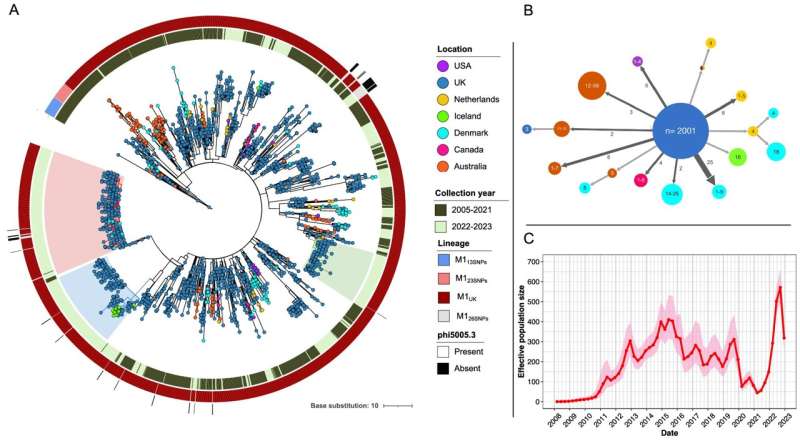This article has been reviewed according to Science X's editorial process and policies. Editors have highlighted the following attributes while ensuring the content's credibility:
fact-checked
peer-reviewed publication
trusted source
proofread
Analysis reveals new insights into global surge of Strep A infections

Strep A (Group A Streptococcus) is a common type of bacteria that typically causes throat infections and scarlet fever. While most infections are mild, in rare cases Strep A can cause invasive infections that can be fatal.
During 2022–2023, health agencies around the world recorded a surge in severe invasive Strep A infections following the lifting of pandemic restrictions. New analysis led by researchers at Imperial College London and the UK Health Security Agency has confirmed that a variant called M1UK played a key role in this increase.
M1 strains are known to cause more invasive infections than other types of Strep A. While it was first identified and sequenced in the UK, M1UK has recently been linked to the rise in numbers of severe infections in Europe, Australia, North America, and Japan seen after pandemic restrictions were lifted. It has also been detected in South America, New Zealand, and Taiwan.
Low levels of Strep A infections during the pandemic are likely to have left populations particularly susceptible to these infections, particularly children, paving the way for the surge in disease seen in many countries.
In a new study into the genetics of M1UK, published in Nature Communications, scientists have provided new insights into when it first emerged and how it compares to other strains.
Using genetic sequencing of samples obtained from patients combined with computer modeling, they found that M1UK likely first emerged in around 2008 before increasing progressively from 2010 onwards.
Compared to earlier M1 strains, which have been relatively unchanged over the last 40 years, M1UK produces more of the toxins that cause scarlet fever.
Professor Shiranee Sriskandan from the Department of Infectious Disease at Imperial College London, who led the research alongside UKHSA colleagues, said, "Bacteria evolve over time, and as Strep A is an exclusively human pathogen, it will acquire genetic changes as it spreads in the population.
"Most variants appear and disappear over time, however M1UK appears to be now established in the UK and other countries. Whether that will remain the case long term is unknown."
Genetic history
Using a search of global genomic databases, the team showed that when M1UK was first found to be present in the UK in 2019, only two M1UK strains could be identified from genome sequences outside the UK.
But subsequent analysis from other countries investigating changing trends in Strep A (including invasive infections) shows M1UK is now present in more than 10 countries around the world, and in some cases became the dominant strain in the post-pandemic period.
The analysis also highlights a bottleneck effect where Strep A infections reduced during the COVID-19 pandemic, coinciding with widespread social distancing and lockdowns. But after this period M1UK rapidly expanded in the UK, with a marked increase in cases of scarlet fever and invasive Strep A infections in 2022.
According to the researchers, while the reduced transmission of Strep A during the pandemic may have led to waning immunity in the population, their work highlights genetic features of M1UK that point to a fitness advantage over other strains, enabling it to be more easily spread and have the potential to cause more severe disease. It may be that increasing population immunity to the M1UK strain may allow other strain types to emerge.
Professor Sriskandan, who is also Clinical Director of the Center for Bacterial Resistance Biology, added, "Although we now know the M1UK variant was behind much of the upsurge seen last winter, it came at a time of year that was unusual, meaning it coincided with respiratory viruses and winter pressures, which all impacted on severity.
"Ultimately the surges we are seeing at different times worldwide are likely due to reduced immunity against specific respiratory pathogens, especially Strep A.
"Vaccines could help to prevent this, and we do need a vaccine against Strep A. These latest insights from our study are only possible thanks to the close collaboration between Imperial's infectious disease researchers and world-leading molecular surveillance by the UK Health Security Agency."
More information: Ana Vieira et al, Rapid expansion and international spread of M1UK in the post-pandemic UK upsurge of Streptococcus pyogenes, Nature Communications (2024). DOI: 10.1038/s41467-024-47929-7


















